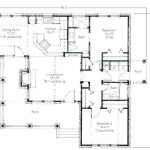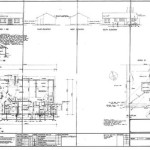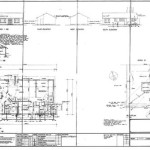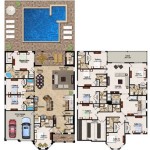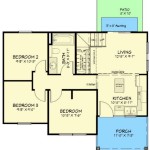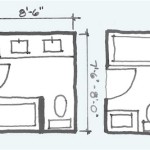Barndominium with Basement Floor Plans: Expanding Space and Functionality
Barndominiums, a fusion of barn construction and modern living spaces, are gaining popularity for their affordability, durability, and customizable designs. One key variation that further enhances the versatility of a barndominium is the addition of a basement. A basement in a barndominium offers a significant increase in usable square footage, providing opportunities for additional living areas, storage, or specialized spaces. This article explores the concept of barndominium floor plans with basements, focusing on design considerations, potential uses, and factors affecting construction and cost.
Understanding the Advantages of a Basement in a Barndominium
Integrating a basement into a barndominium design provides numerous benefits. Foremost among these is the expansion of living space without altering the building's footprint. In areas where above-ground expansion might be restricted by zoning regulations or property limitations, a basement represents an efficient solution for adding bedrooms, recreational areas, or home offices. Furthermore, basements naturally offer excellent insulation properties. The earth surrounding the basement walls helps to regulate temperature, contributing to lower heating and cooling costs throughout the year. This thermal mass effect can be particularly beneficial in climates with extreme temperature variations.
Beyond living space, basements excel as storage areas. They can accommodate seasonal items, tools, equipment, and other belongings, keeping the above-ground living areas uncluttered. The secure and often climate-controlled environment of a basement also makes it suitable for storing valuable items or creating wine cellars. Moreover, a basement can serve as a storm shelter, providing a safe haven during severe weather events. In regions prone to tornadoes or hurricanes, a reinforced basement can offer crucial protection.
From a functional perspective, basements offer the opportunity to create specialized spaces. Home theaters, game rooms, workshops, or even home gyms can be seamlessly integrated into the basement level. The separation from the main living area allows for noise isolation and dedicated use, minimizing disruption to other household activities. Consider plumbing needs when designing a barndominium basement. Sinks, showers, and toilets require proper drainage, and locating these features near existing plumbing lines can reduce construction costs. Also, ensure adequate ventilation within the basement to prevent moisture buildup and maintain air quality.
Design Considerations for Barndominium Basement Floor Plans
Planning a barndominium with a basement necessitates careful consideration of several design elements. The foundation is critical, and a poured concrete foundation is generally preferred for its strength and water resistance. The design should incorporate proper drainage systems to prevent water infiltration, including exterior drainage around the foundation and interior sump pumps to remove any accumulated water. Water intrusion can lead to mold growth, structural damage, and health problems, so proactive measures are essential.
Basement access is another important design consideration. Interior staircases provide convenient access from the main living area, while exterior access via walk-out basements or separate entrances can offer greater flexibility. Walk-out basements are particularly desirable as they allow for natural light and ventilation, making the space feel less confined. Natural light significantly enhances the livability of a basement. Strategically placed windows and window wells can maximize sunlight penetration. Egress windows, which meet specific size requirements to allow for emergency escape, are also crucial for safety in bedrooms and other habitable areas.
Interior layout planning should prioritize efficient use of space. Partition walls can be used to create distinct rooms or zones, while leaving some areas open can enhance the feeling of spaciousness. Consider the placement of structural supports, such as columns and load-bearing walls, to minimize their impact on the layout. Adequate ceiling height is essential for comfort. Building codes often specify minimum ceiling heights for habitable basement areas, and exceeding these minimums can significantly improve the overall usability of the space. Careful planning of electrical and plumbing systems is also crucial to ensure that the basement meets the needs of its intended use. Electrical outlets, lighting fixtures, and plumbing fixtures should be placed strategically to maximize functionality and convenience.
The type of soil on-site will significantly influence the construction process for a barndominium basement. Soil testing is usually required to determine its load-bearing capacity and drainage characteristics. Expansive soils, which swell and shrink with changes in moisture content, can exert considerable pressure on foundation walls. In such cases, special foundation designs may be necessary to mitigate the risk of damage. The presence of groundwater can also pose challenges. If the water table is high, additional waterproofing measures may be required to prevent water infiltration.
Key Elements in Developing a Basement Floor Plan
Developing a functional and aesthetically pleasing basement floor plan requires an understanding of several key elements. These include determining the optimal use of the basement space, incorporating adequate natural light and ventilation, and designing the space to meet specific needs and preferences.
The first step in creating a basement floor plan is to determine how the space will be used. Will it be a living area, a storage area, a recreational space, or some combination of these? The intended use will influence the layout, the placement of walls and partitions, and the selection of finishes and fixtures. For example, if the basement is intended as a home theater, soundproofing materials and specialized lighting will be necessary. If it's designed as a guest suite, a bathroom and kitchenette might be required. Considering future needs is also wise. Even if the current plan focuses on storage, designing the space to be easily converted into a living area later can add value and flexibility.
Maximizing natural light and ventilation is crucial for creating a habitable basement. Egress windows, as mentioned earlier, are essential for safety and can also provide a significant amount of natural light. Window wells can be used to increase the amount of light entering the basement through these windows. In addition to windows, consider incorporating skylights or light tubes to bring natural light into areas that might otherwise be dark and gloomy. Proper ventilation is equally important for preventing moisture buildup and maintaining air quality. Exhaust fans in bathrooms and kitchens can help to remove excess moisture, while dehumidifiers can be used to control humidity levels in the basement. A well-ventilated basement will be more comfortable and less prone to mold growth.
Finally, the basement should be designed to meet specific needs and preferences. This includes taking into account family size, lifestyle, and personal taste. If the family enjoys entertaining, a large open space for gatherings might be desirable. If there are children in the family, a dedicated play area or playroom could be beneficial. Personal taste should also be factored into the design. The color scheme, the flooring materials, and the style of fixtures and furnishings should all reflect individual preferences. A well-designed basement will not only be functional but also aesthetically pleasing and comfortable to live in.
Factors Affecting Construction and Costs
The construction of a barndominium with a basement is a complex undertaking that involves several factors that can impact costs and timelines. These factors include soil conditions, the complexity of the design, accessibility of the site, and the selection of materials and finishes.
Soil conditions, as previously mentioned, can significantly influence construction costs. Expansive soils or the presence of groundwater can necessitate specialized foundation designs and waterproofing measures, which can add to the overall cost. A thorough soil analysis is essential for identifying potential problems and developing appropriate solutions. The complexity of the basement design also plays a crucial role. A simple rectangular basement with minimal partitioning will be less expensive to build than a complex design with multiple rooms, angled walls, and intricate plumbing and electrical systems. The inclusion of features like walk-out basements or separate entrances can also increase the cost.
Site accessibility can also be a significant factor. If the site is difficult to access, it may be more expensive to transport materials and equipment to the site. This can be particularly problematic in rural areas or on sites with steep slopes or limited road access. The selection of materials and finishes can also have a substantial impact on costs. High-end finishes, such as hardwood flooring, granite countertops, and custom cabinetry, will be more expensive than more basic alternatives. Similarly, energy-efficient windows and insulation can increase the initial cost but can also lead to long-term savings on energy bills. Carefully weighing the cost and benefits of different materials and finishes is essential for staying within budget.
Permitting and inspection fees can also contribute to the overall cost of a barndominium with a basement. Building permits are typically required for any construction project that involves structural alterations or additions, and these permits can be expensive. Additionally, regular inspections are required to ensure that the construction complies with building codes. These inspections can also add to the overall cost. Obtaining the necessary permits and adhering to building codes is essential for ensuring the safety and legality of the construction project.

The New Guide To Barndominium Floor Plans Houseplans Blog Com

Farmhouse Inspired Barndominium With Wraparound Porch 135072gra Architectural Designs House Plans

Home Floor Plan 5 Bedroom Barndominium Plans For Free Nicepng Provides Large R 4 Barn Homes

The New Guide To Barndominium Floor Plans Houseplans Blog Com

High Quality Finished Basement Plans 5 Walk Out Floor Barndominium

The New Guide To Barndominium Floor Plans Houseplans Blog Com

Discover Why Farmhouse Barndominium Plans Are All The Rage Blog Eplans Com

Building Your Dream Barndo Barndominium Floor Plans That Will Amaze And Inspire

The New Guide To Barndominium Floor Plans Houseplans Blog Com

Building Your Dream Barndo Barndominium Floor Plans That Will Amaze And Inspire

